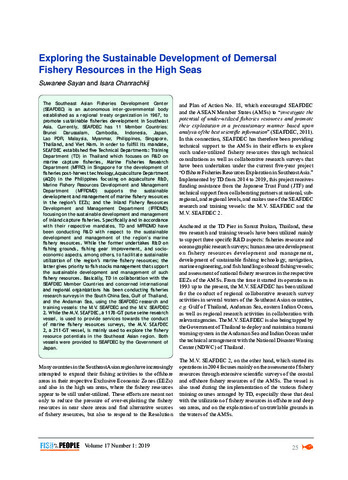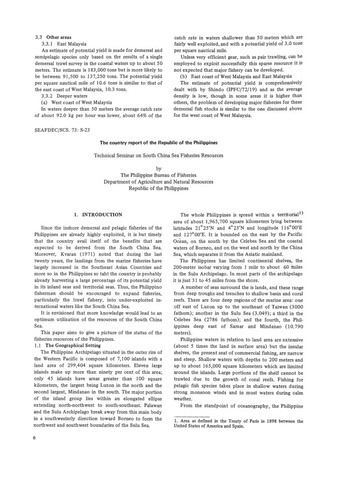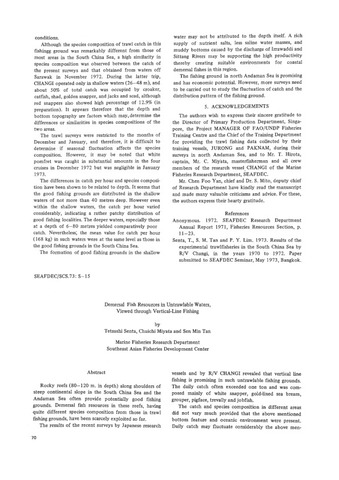Exploring the sustainable development of demersal fishery resources in the high seas
Share
抄録
The Southeast Asian Fisheries Development Center (SEAFDEC) is an autonomous inter-governmental body established as a regional treaty organization in 1967, to promote sustainable fisheries development in Southeast Asia. Currently, SEAFDEC has 11 Member Countries: Brunei Darussalam, Cambodia, Indonesia, Japan, Lao PDR, Malaysia, Myanmar, Philippines, Singapore, Thailand, and Viet Nam. In order to fulfill its mandate, SEAFDEC established five Technical Departments: Training Department (TD) in Thailand which focuses on R&D on marine capture fisheries, Marine Fisheries Research Department (MFRD) in Singapore for the development of fisheries post-harvest technology, Aquaculture Department (AQD) in the Philippines focusing on aquaculture R&D, Marine Fishery Resources Development and Management Department (MFRDMD) supports the sustainable development and management of marine fishery resources in the region’s EEZs; and the Inland Fishery Resources Development and Management Department (IFRDMD) focusing on the sustainable development and management of inland capture fisheries. Specifically and in accordance with their respective mandates, TD and MFRDMD have been conducting R&D with respect to the sustainable development and management of the region’s marine fishery resources. While the former undertakes R&D on fishing grounds, fishing gear improvement, and socioeconomic aspects, among others, to facilitate sustainable utilization of the region’s marine fishery resources; the latter gives priority to fish stocks management that support the sustainable development and management of such fishery resources. Basically, TD in collaboration with the SEAFDEC Member Countries and concerned international and regional organizations has been conducting fisheries research surveys in the South China Sea, Gulf of Thailand, and the Andaman Sea, using the SEAFDEC research and training vessels: the M.V. SEAFDEC and the M.V. SEAFDEC 2. While the M.V. SEAFDEC, a 1178-GT purse seine research vessel, is used to provide services towards the conduct of marine fishery resources surveys, the M.V. SEAFDEC 2, a 211-GT vessel, is mainly used to explore the fishery resource potentials in the Southeast Asian region. Both vessels were provided to SEAFDEC by the Government of Japan.
Suggested Citation
Sayan, S., & Chanrachkij, I. (2019). Exploring the sustainable development of demersal fishery resources in the high seas. Fish for the People , 17(1), 25-30. http://hdl.handle.net/20.500.12066/4812
主題
Collections
Related items
Showing items related by title, author, creator and subject.
-
Upholding local knowledge for sustainable fishery of the unicorn leatherjacket filefish aluterus monoceros: A case in Malaysia
Md Saleh, Mohammad Faisal (Secretariat, Southeast Asian Fisheries Development Center, 2014)The unicorn leatherjacket Aluterus monoceros (Linnaeus 1758) is a filefish of the family Monacanthidae. Locally known as 'ikan barat-barat' in Malaysia, this species is a demersal fish found in sub-tropical areas around ... -
The country report of the Republic of the Philippines: Technical seminar on South China Sea fisheries resources
The Philippine Bureau of Fisheries, Department of Agriculture and Natural Resources (Japan International Cooperation Agency, 1977)The paper provides information on the status of the fisheries resources in the Philippines. It presented data on the pelagic, demersal and other resources including aquaculture and minor sea products. The productions of ... -
Demersal fish resources in untrawlable waters, viewed through vertical-line fishing
Senta, Tetsushi; Miyata, Chuichi; Tan, Sen-Min (Japan International Cooperation Agency, 1977)Rocky reefs (80-120 m. in depth) along shoulders of steep continental slope in the South China Sea and the Andaman Sea often provide potentially good fishing grounds. Demersal fish resources in these reefs, having quite ...





